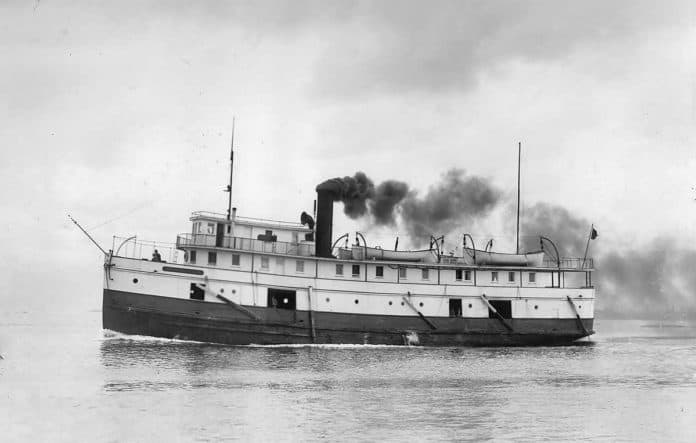
OWEN SOUND – Today, March 10, 2021, marks exactly 100 years since the founders of Owen Sound Transportation Company (OSTC), the present-day operator of the MS Chi-Cheemaun ferry between South Baymouth and Tobermory, filed their letters patent to launch the company as a competitor in the busy Lake Huron shipping trade of the early 20th century.
“The planned 100th year celebrations for 2021 have turned into a low-key commemoration: an interactive permanent installation on the original OSTC property down on the Owen Sound Harbour, adjacent to where the ship winters,” said OSTC president and CEO Susan Schrempf in an email to The Expositor on the occasion of the centennial.
Details about the historical installation will come forth later this spring once the piece is ready for the public’s eye. OSTC plans to hold a small-scale outdoor event for the unveiling, abiding by applicable physical distancing requirements.
OSTC began operations in 1921 as a primarily freight-oriented company. It served the interests of Owen Sound businessmen who owned the North American Bent Chair Company. Bentwood chairs are those that use single, bent pieces of wood for their frame and the chair company, founded in 1892, was the first in Canada to use the process, which originated in Austria in 1845.
The entrepreneurs saw OSTC as an arm of their business to both gather and deliver raw wood supplies from around Lake Huron, including Manitoulin Island, as well as a way to ship their finished products to ports farther afield.
“William Gray Hay, James Merritt Hay and Howard Bovell, Manufacturers; James Garvie, Accountant; and Gordon McIntosh, Traveller; all of the City of Owen Sound, in the County of Grey and Province of Ontario; and any others who have become subscribers to the Memorandum of Agreement of the Company, and persons who hereafter become shareholders therein, a Corporation under the name of
“The Owen Sound Transportation Company, Limited
“For the following purposes and objects, that is to say:
“To carry on the business of the general transportation of goods, merchandise and passengers upon land or water, and a general towing business on water; to construct and build or purchase the necessary ships, tugs, scows and boats of every nature and kind whatsoever, together with all the materials, articles, tools, machinery and appliances entering into or suitable and convenient for the construction of equipment thereof, and together with engines, boilers, machinery and appurtenances of all kinds, tackle, apparel and furniture of all kinds, and to own, operate and maintain steamship lines, vessel lines or other lines of transportation:
“Provided, however, that nothing in these Letters Patent contained shall be deemed or construed or authorize or empower the Company to operate or control any public utility or municipal franchise within the meaning of the provisions of Part XII of The Ontario Companies Act until authorized to do so by Supplementary Letters Patent,” read a portion of OSTC’s letters patent.
The letters listed the company’s capital as $40,000, divided into 4,000 shares of $10, and its initial three directors were Mr. Gray Hay, Mr. Garvie and Mr. Merritt Hay.
Provincial secretary Harry Corwin Nixon signed the letters in Toronto on March 10, 1921. On March 21, the provincial registrar officially recorded them.
The company’s fleet began with the first SS Michipicoten, a freight ship. Five years after its inception, the partners purchased a passenger steamship, Modjeska, a twin-screw daytripper vessel that was slow, accident-prone and almost always listed to one side, according to Maritime History of the Great Lakes.
At the time of purchase, it was reportedly in poor condition after its previous owner, Canada Steamship Lines, only completed partial repairs after a collision.
OSTC renamed Modjeska to Manitoulin and entered it into service along the ‘Turkey Trail’ between Owen Sound and Sault Ste. Marie via the North Channel. It completed extensive renovations that improved its handling and passenger quarters, including upgraded accommodations and an abundance of concrete in its hull for stabilizing ballast. These upgrades earned the ship a much better reputation.
A combination of the ship’s age, the introduction of the Norisle in 1946 and new fire-prevention regulations that Manitoulin would never have met led to the ship’s retirement in 1949.
The Norisle was the first steamship built in Canada after the Second World War and featured engines designed for a navy corvette. It travelled through Lake Huron alongside the older Normac (named after Norman MacKay, the captain of the Manitoulin and general manager of OSTC) and the Norgoma, built in 1950.
The Normac left OSTC ownership in 1968 and later became Captain John’s Harbour Boat Restaurant in Toronto, before eventually arriving at its current home in Port Dalhousie on Lake Ontario.
Norisle and Norgoma operated the ferry run between Manitoulin and the Bruce Peninsula until 1974, when OSTC introduced the MS Chi-Cheemaun, built in Collingwood, to replace both ships. OSTC brought in an extra ship to serve alongside the Chi-Cheemaun in 1989 and renamed it MV Nindawayma. Due to ‘unsatisfactory performance,’ it left service three years later in 1992 and went to scrap in 2007.
Norgoma has been docked in Sault Ste. Marie for 30 years but its fate is in question after that city listed the ship for sale in September 2019. The Norisle remains moored at Burns Wharf in Manitowaning.
Several other ships made up OSTC’s roster over the past century, including the SS Hibou, SS Manasoo, SS Manitou and SS Caribou.
The Chi-Cheemaun continues to provide the daily seasonal ferry service between South Baymouth and Tobermory, through changes in the company’s ownership structure and renovations to the ship over the years.
Despite the storied past, the occasion of OSTC’s centennial will not carry the pomp and circumstance that might otherwise be expected.
“Two years ago we were preparing to hold an initial celebration on the spring cruise 2021, and have the concert cruises and other events through the season all follow that theme, but then the pandemic happened and the writing was on the wall. The pandemic situation would not improve sufficiently to support that kind of group activity in 2021,” Ms. Schrempf told The Expositor.
Although this year’s spring cruise is cancelled, the ferry service is slated to begin just under two months from today on Friday, May 7. Operations will continue to follow Transport Canada’s pandemic measures for passenger ships until the federal government revises these measures.





